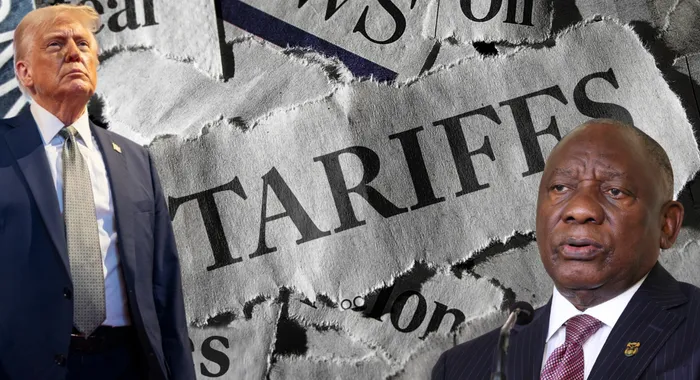30% US tariff hike impact on South African economy
Profit margins

South Africa will be hit with a 30% tariff on all its exports to the United States from August 1, following a formal letter from US President Donald Trump to President Cyril Ramaphosa demanding action on trade imbalances and long-standing market restrictions.
Image: Lee Rondganger/IOL
RECENT developments in international trade policies have culminated in a significant 30% tariff hike imposed by the United States on South African exports. Such a substantial increase in tariffs is poised to ripple through South Africa's economic fabric, affecting everything from corporate profitability and employment to currency stability and monetary policy.
For SA, a country intricately linked to global commodity markets and sensitive to trade disruptions, this move presents both immediate and long-term challenges. The imposition of this 30% tariff by the United States on a broad range of South African imports, effective from August 1, 2025, marks a pivotal and concerning shift in bilateral trade relations.
While specific sectors like Platinum Group Metals (PGMs), gold, chrome, and coal are explicitly exempted, and others like automotive and steel/aluminium face different, often higher, rates, this move effectively signals the end of South Africa's preferential access under the African Growth and Opportunity Act (AGOA).
1. Direct impact on South African businesses
The SA economy relies heavily on exports, notably minerals (platinum, gold, chrome), agricultural products, and manufactured goods. The imposition of a 30% tariff increase by the US significantly raises the cost of these exports, making South African goods less competitive in the American market.
This threat could translate into a decrease in US demand, potentially translating to a decline in sales volumes and revenue for industries for us, given that the US constitutes a key export destination, such as mining and manufacturing. Higher tariffs raise the cost for American importers of South African goods, which often leads to reduced demand or a need to absorb cost increases to maintain market share.
For exporters, lower sales directly affect profit margins, potentially forcing cost-cutting measures, including layoffs, which increase domestic unemployment. Small and medium-sized businesses, with less financial resilience, are particularly vulnerable, risking closures amid decreased revenues and potentially an increase in the number of bankruptcies.
Several South African industries rely on imported components or intermediate goods from the US or elsewhere. Increased tariffs may compound costs, disrupt supply chains and delay production schedules. Over the medium term, uncertainty regarding trade policies could dampen investment as firms defer expansion or modernisation plans due to unpredictable export conditions.
The broader economy also faces indirect effects: reduced foreign exchange earnings can constrain government revenues, limit funding for social and infrastructural projects, and slow economic growth. As exports shrink, the trade balance deteriorates, causing economic activity to decline.
2. Currency dynamics: impact on the rand and the dollar
In the short term, the rand typically depreciates in response to negative trade news and waning investor confidence. A 30% tariff hike by the US suggests decreased demand for South African exports, leading to a decline in dollar-denominated inflows. Capital markets may react swiftly, with foreign investors withdrawing or re-evaluating holdings, seeking safer assets.
The rand/dollar exchange rate will likely weaken, potentially breaching key support levels, especially if the tariff hike leads to fears of a broader trade conflict or economic downturn. The extent of depreciation depends on market sentiment, existing macroeconomic fundamentals, and the South African Reserve Bank’s (SARB) interventions.
Continuous depreciations could also escalate, feeding into inflationary pressures.Uncertainty regarding US trade policy stability could potentially increase volatility and increase speculative activity in the rand. This uncertainty complicates businesses’ hedging strategies and raises the cost of imported goods and capital.
3. Inflationary pressures
A weaker rand increases the cost of imported goods and raw materials, directly fuelling inflation if domestic producers pass on higher costs to consumers. The inflationary impact could be significant for South Africa, which relies heavily on imported machinery, fuel, and components.
Higher input costs translate into increased prices for domestically produced goods and services, especially in manufacturing, construction, and transportation sectors. This scenario risks triggering a wage-price spiral if inflation expectations become entrenched. The combined effect of imported inflation, increased transportation costs due to weaker currency, and possible supply chain disruptions can lead to a broad-based rise in consumer prices, eroding purchasing power, especially for lower-income households.
4. Monetary policy and interest rate trajectories
To counter mounting inflationary pressures, the SARB may consider tightening monetary policy. An increase in interest rates could be employed to anchor inflation expectations, stabilise the currency, and prevent inflation from becoming entrenched.However, higher interest rates could dampen economic growth, exacerbate unemployment, and strain indebted borrowers. The delicate balance requires careful calibration, especially given the inflationary impetus from currency depreciation.
The tariff increase may lead to rand weakness and potentially a lower demand for SA goods and services, hurting mid-sized businesses the most. These economic changes are likely to impact jobs, leading to an increase in domestic inflation and higher interest rates.

Advocate Lavan Gopaul
Image: File
Advocate Lavan Gopaul is the director of Merchant Afrika.
** The views expressed do not necessarily reflect the views of IOL or Independent Media.
Related Topics: